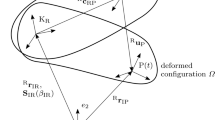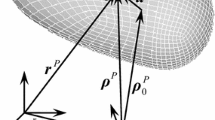Abstract
The difference between the classical treatment offlexible body impact and the treatment of impact in flexiblemultibody dynamics is due to several fundamental reasons. Inthe classical impact theory, simple structures such as beamsand plates are used. Infinite dimensional models can bedeveloped for these simple structural elements to study theimpact dynamics and the wave propagation problem. Flexiblemultibody impact problems, on the other hand, involve bodieswith complex geometry that cannot be modeled using infinitenumber of degrees of freedom. Furthermore, the classicalimpact theory has been mainly concerned with the impactbetween a rigid mass that moves without constraints beforeit impacts a simple flexible structure. This is not amultibody simulation scenario in which the impact occursbetween kinematically constrained bodies that are subjectedto impulsive constraint forces in addition to the impactforces. These constraint forces can influence the motion ofthe two bodies immediately after impact, and as aconsequence, the simple classical theory scenario of impactdoes not apply. It is the objective of this paper to discussthe use of the restitution condition in flexible multibodyimpact problems and demonstrate that the use of thisapproach does not exclude the classical formulation.Nonetheless, the impulse momentum balance approach can serveas an effective and efficient procedure for solving theimpact problem in finite dimensional models that do not obeythe classical wave theory. Energy results of simplestructural elements are presented in order to demonstratethe consistency of using the impulse momentum balanceapproach in solving impact problems in finite dimensionalflexible body applications.
Similar content being viewed by others
References
Fowles, G. R., Analytical Mechanics, 4th edition, Saunders College Publishing, 1986.
Greenwood, D. T., Principles of Dynamics, 2nd edition, Prentice Hall, Englewood Cliffs, 1988.
Khulief, Y. A. and Shabana, A. A., 'Dynamics of multibody systems with variable kinematic structure', ASME Journal of Mechanisms, Transmissions, and Automation in Design 108(2), 1986, 167–175.
Chang, C. W. and Shabana, A.A., 'Spatial dynamics of deformable multibody systems with variable kinematic structures, Parts I & II', ASME Journal of Mechanical Design 112(2), 1990, 153–167.
Gau, W. H. and Shabana, A. A., 'Use of the generalized impulse momentum equations in analysis of wave propagation', ASME Journal of Vibration and Acoustics 113(4), 1991, 532–542.
Love, A.E. H., A Treatise on the Mathematical Theory of Elasticity, 4th edition, Dover Publications, Oxford, 1944.
Kolsky, H., Stress Waves in Solids, Dover Publications, Oxford, 1963.
Witham, G. B., Linear and Nonlinear Waves, Wiley, New York, 1974.
Bland, D. R., Wave Theory and Applications, Clarendon Press, Oxford, 1988.
Huebner, K. H., Thornton, E. A., and Byrom, T. G., The Finite Element Method for Engineers, 3rd edition, Wiley, New York, 1995.
Cook, R. D., Malkus, D. S., and Plesha, M. E., Concepts and Applications of Finite Element Analysis, 3rd edition, Wiley, New York, 1989.
Cook, R. D., Finite Element Modeling for Stress Analysis, Wiley, New York, 1995.
Shabana, A. A., Dynamics of Multibody Systems, 2nd edition, Cambridge University Press, Cambridge, 1998.
Shabana, A. A., Computational Dynamics, 2nd edition, Wiley, New York, 2001.
Rismantab-Sany, J. and Shabana, A. A., 'On the use of the momentum balance in the impact analysis of constrained elastic systems', ASME Journal of Vibration and Acoustics 112(2), 1990, 119–126.
Escalona, J. L., Mayo, J. M., and Domínguez, J., 'New numerical method for dynamic analysis of impact loads in flexible beams', Mechanism and Machine Theory 34, 1999, 765–780.
Escalona, J. L., Mayo, J. M., and Domínguez, J., 'A critical study of the use of the generalized impulsemomentum balance equations in flexible multibody systems', Journal of Sound and Vibration 217(3), 1998, 523–545.
Yigit, A. S. and Christoforou, A. P., 'Impact dynamics of composite beams', Composite Structures 32, 1995, 187–195.
Timoshenko, S. P., Theory of Elasticity, 3rd edition, McGraw-Hill, New York, 1970.
Author information
Authors and Affiliations
Rights and permissions
About this article
Cite this article
Escalona, J.L., Sany, J.R. & Shabana, A.A. On the Use of the Restitution Condition in Flexible Body Dynamics. Nonlinear Dynamics 30, 71–86 (2002). https://doi.org/10.1023/A:1020337204996
Issue Date:
DOI: https://doi.org/10.1023/A:1020337204996




